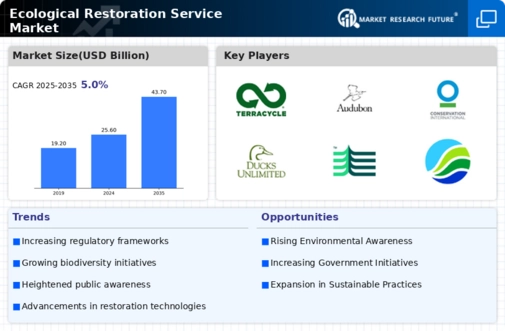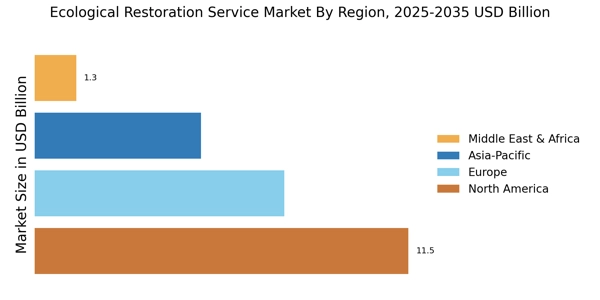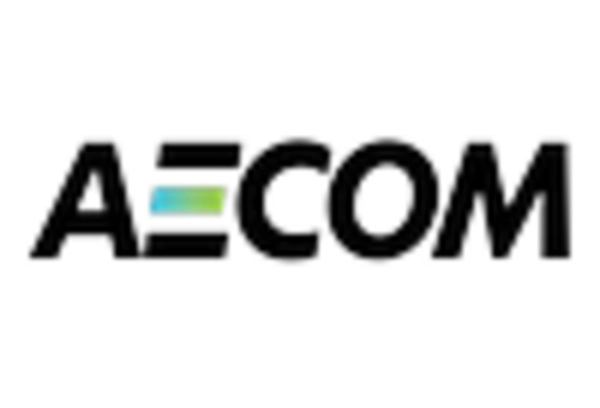Public-Private Partnerships
The Ecological Restoration Service Market is increasingly benefiting from the establishment of public-private partnerships (PPPs). These collaborations between government entities and private organizations facilitate the pooling of resources, expertise, and funding for restoration projects. Such partnerships are particularly effective in addressing large-scale ecological challenges, as they leverage the strengths of both sectors. For instance, governments may provide regulatory support and funding, while private companies contribute innovative technologies and management practices. The trend towards PPPs is likely to enhance the efficiency and effectiveness of restoration efforts, leading to improved outcomes for ecosystems. As more stakeholders recognize the value of collaborative approaches, the ecological restoration service market is poised for growth, driven by these synergistic relationships.
Climate Change Mitigation Efforts
The Ecological Restoration Service Market is increasingly influenced by the urgent need to address climate change. Restoration projects are recognized as effective strategies for carbon sequestration, biodiversity enhancement, and ecosystem resilience. Governments and organizations are prioritizing ecological restoration as part of their climate action plans, with many committing to ambitious targets for reducing greenhouse gas emissions. For instance, the restoration of wetlands and forests has been shown to significantly contribute to carbon capture, which is essential in mitigating climate change impacts. As climate policies evolve, the demand for ecological restoration services is expected to grow, creating new opportunities for service providers and reinforcing the industry's role in global sustainability efforts.
Corporate Sustainability Commitments
The Ecological Restoration Service Market is witnessing a shift as corporations increasingly adopt sustainability commitments. Many companies are integrating ecological restoration into their corporate social responsibility (CSR) strategies, recognizing the importance of environmental stewardship in enhancing their brand image and stakeholder relations. This trend is particularly evident in industries such as agriculture, forestry, and construction, where companies are investing in restoration projects to offset their environmental impact. Reports indicate that businesses are allocating substantial resources towards ecological restoration, which not only aids in compliance with environmental regulations but also fosters community goodwill. As corporate sustainability becomes a priority, the demand for ecological restoration services is expected to rise, creating a symbiotic relationship between corporate interests and environmental health.
Biodiversity Conservation Initiatives
The Ecological Restoration Service Market is significantly shaped by the increasing emphasis on biodiversity conservation. As species extinction rates rise, there is a pressing need for restoration projects that aim to rehabilitate habitats and promote species recovery. Various international agreements and national policies are being established to protect biodiversity, which in turn drives demand for ecological restoration services. For example, initiatives aimed at restoring degraded ecosystems are often linked to broader conservation strategies, thereby enhancing the ecological integrity of regions. The market is likely to benefit from these initiatives, as stakeholders recognize the intrinsic value of biodiversity and the ecosystem services it provides, leading to a more robust demand for restoration services.
Increased Investment in Environmental Initiatives
The Ecological Restoration Service Market is experiencing a surge in investment as governments and private entities recognize the necessity of environmental restoration. This trend is driven by a growing understanding of the economic benefits associated with healthy ecosystems, which can lead to increased tourism, improved public health, and enhanced property values. In recent years, funding for ecological restoration projects has seen a notable rise, with estimates suggesting that investments could reach billions annually. This influx of capital not only supports restoration efforts but also stimulates job creation within the sector, thereby reinforcing the industry's growth trajectory. As stakeholders become more aware of the long-term advantages of ecological restoration, the market is likely to expand further, attracting diverse investments aimed at sustainable development.


















Leave a Comment